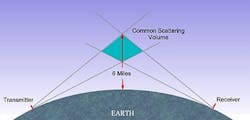Army revisits troposcatter communications technology as alternative to long-range SATCOM
ABERDEEN PROVING GROUND, Md., 26 July 2013. U.S. Army researchers are reaching out to industry for fresh ideas on tropospheric scatter (troposcatter) technologies for fixed-site and on-the-move long-range military communications as an alternative to satellite communications (SATCOM).
Troposcatter communications transmits and receives microwave signals at beyond-line-of-sight distances as far as 200 miles without SATCOM by bouncing radio signals off layers of the Earth's atmosphere.
The Army Contracting Command at Aberdeen Proving Ground, Md., issued a request for information (W15P7T-13-R-A430) this week about RF and microwave troposcatter technologies for beyond light-of-sight telecommunications.
Troposcatter communications mode scatters radio waves as they pass through upper layers of Earth's lowest layer of atmosphere, called the troposphere, where most of the planet's water vapor resides. Army officials issued the RFI on behalf of the Army Communications Electronics Research & Development Engineering Center (CERDEC), Space & Terrestrial Communications Directorate (S&TCD) at Aberdeen Proving Ground.
Troposcatter communications transmit radio signals in tight beams aimed at the tropopause located midway between the transmitter and receiver sites. The tropopause is the boundary between the troposphere and the stratosphere.
While traditional line-of-sight microwave communications use frequencies between 12 and 19 GHz, troposcatter communications use frequencies around 2 GHz. Only a small portion of troposcatter radio waves can be received, so large high-gain dish antennas are necessary.
Military forces have been using troposcatter communications in various forms since the 1960s to transmit voice and data without the use of satellites or high-frequency (HF) radio signals. HF radio offers global coverage without satellites, but is low bandwidth and sometimes unreliable.
One of the best-known U.S. military troposcatter communications systems was the Cold War-era Tri-Services Tactical Communications Program (TRI-TAC), a strategic command, control, communications, and intelligence (C3I) system abandoned in 2002 that fielded tactical and multichannel systems.
The AN/TYC-39 message switch component of TRI-TAC provided secure, automatic switching of traffic using troposcatter communications, as well as multichannel line-of-sight communications and SATCOM.
Troposcatter communications typically are secure because their radio waves are difficult for enemies to intercept, hence their interest for military communications. Among the companies that have been involved in troposcatter communications are General Dynamics, Raytheon Co., Microwave Radio Communications (MRC), Lockheed Martin Corp., ITT Exelis, and Comtech.
Army researchers are interested in troposcatter communications technology for worldwide operation that is reliable in a wide variety of environmental conditions, reduces or eliminates the need for communications relay sites, works in rugged terrain, automatically adjusts data rates due to atmospheric changes, communicates IP voice, data messaging, and multimedia services simultaneously over ranges of at least 25 miles, has an easy-to-use graphic user interface, and that is small, lightweight, and man-portable.
Army officials say that although this is not a request for proposals, they will use the information they gain from this RFI in developing an acquisition strategy, work statements, or performance specifications.
Companies interested should email information to the Army's Kevin Chin no later than 23 Aug. 2013 at [email protected].
For questions or concerns contact the Army's Michael Levy by phone at 443-861-4615, or by email at [email protected].
